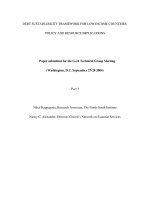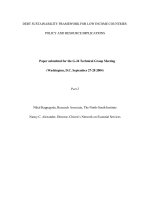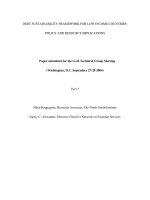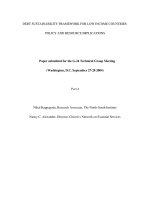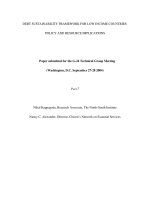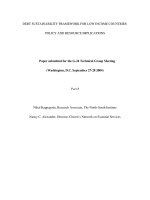DEBT SUSTAINABILITY FRAMEWORK FOR LOW INCOME COUNTRIES: POLICY AND RESOURCE IMPLICATIONS doc
Bạn đang xem bản rút gọn của tài liệu. Xem và tải ngay bản đầy đủ của tài liệu tại đây (512.8 KB, 87 trang )
DEBT SUSTAINABILITY FRAMEWORK FOR LOW INCOME COUNTRIES:
POLICY AND RESOURCE IMPLICATIONS
Paper submitted for the G-24 Technical Group Meeting
(Washington, D.C. September 27-28 2004)
Part 1
Nihal Kappagoda, Research Associate, The North-South Institute
Nancy C. Alexander, Director, Citizen’s Network on Essential Services
CONTENTS
Executive Summary
Introduction 1
Debt Sustainability and Debt Indicators 2
Debt Sustainability Framework 6
Debt Distress 7
Performance Based Allocation System 10
Allocation of Grants 14
Financing of Grants 15
Concerns and Issues 16
Debt Sustainability Framework 16
The PBA System 17
Other Issues 18
Conclusions and Recommendations
18
CPIA 20
Debt Thresholds and Indicators 21
Annexes
1. Debt Indicators 23
2. Country Performance Ratings for 2003 25
3. List of References
32
ABBREVIATIONS
CPIA Country Policy and Institutional Assessment
DSA Debt Sustainability Analysis
DSF Debt Sustainability Framework
GDP Gross Domestic Product
GNI Gross National Income
HIPC Highly Indebted Poor Countries
IDA International Development Association
ICP IDA Country Performance
IMF International Monetary Fund
IFI International Financial Institution
MDG Millennium Development Goal
PBA Performance Based Allocation
PNG Private Non Guaranteed
PV Present Value
EXECUTIVE SUMMARY
The Debt Sustainability Framework sets out a proposal by the World Bank
for identifying countries in actual or potential debt distress situations
leading to a formula for determining grant eligibility within the amounts to
be allocated during the Fourteenth Replenishment of IDA. It attempts to
classify countries based on the performance of their institutions and policies
and determine thresholds for selected debt indicators for each country
grouping and then estimate the level of debt distress as measured by the
forecast levels of the selected indicators from the country DSAs. This leads
to a formula for determining grant eligibility within the IDA allocation
made on the basis of the Performance Based Allocation System that uses
the Country Policy and Institutional Assessment and governance rating of
the country concerned. The increase in grants has implications for the
future of IDA funding which also needs consideration.
Although called the Debt Sustainability Framework it does not provide a
mechanism to ensure that bilateral and other multilateral donors will act in
accord with IDA in their lending so that low income countries could reduce
their debt vulnerability. This is particularly important when IDA accounts
for only a small share of a country’s external borrowing. It also begs the
question about action that should be taken about current high levels of debt
stock. Effective donor coordination will be necessary to achieve debt
sustainability which is the objective of the new allocation system. The
international community needs to address this issue at the time the DSF is
approved in the same way that it was done when the HIPC Initiative was
launched.
There are differences between the HIPC Initiative and the DSF. The former
was intended to deal with the debt overhang brought about by past
borrowing, while the Framework is intended to reduce the accumulation of
future debts of low income countries to unsustainable levels. While the
HIPC Initiative used a single indicator, that is the ratio of debt to exports to
judge sustainability the DSF selects three debt ratios which are the present
value of public and publicly guaranteed external debt to gross domestic
product and to exports, and debt service on the same debt to exports to
judge debt sustainability. Country policies and institutional capability and
vulnerability to shocks are other factors identified as being important for
assessing a country’s debt sustainability.
The DSF uses the Country Policy and Institutional Assessments done for
each borrowing country to classify countries by performance and determine
different debt ratio thresholds for the selected indicators. The allocations
under IDA 14 will be based on the Performance Based Allocation System
which is based on the level of poverty measured by per capita income and
performance assessed by the CPIA and governance. The level of debt
distress of a country is measured in relation to the debt ratio thresholds for
the relevant country grouping leading to an assessment of grant eligibility.
The World Bank will allocate funds for low-income countries taking into
account both “need” and “performance.” Country performance is to be
assessed using the CPIA comprised of four clusters accounting for 80
percent of a country’s rating. Further it will rate each government’s
performance on the portfolio of outstanding loans. This accounts for 20
percent of the rating. The level of grants and credits (loans on soft IDA
terms) to which a low income country has access will increase or decrease
as a result of the Bank’s application of a “governance factor” to its CPIA
and portfolio performance ratings. The governance factor is given a high
weight relative to other criteria.
The proposed grant allocation system in IDA 14 will be based on the
thresholds of the selected debt indicators for the groups of countries that are
classified as strong, medium and poor performers based on the CPIAs.
Forecast levels of the selected debt indicators will take account of the
impact of exogenous shocks to the extent these can be forecast in the
country debt sustainability analyses (DSAs). Countries that are judged to
be high risk based on the debt sustainability analyses DSAs will receive the
entire IDA allocation as grant funds. Countries that are judged to be of
medium debt risk will receive 50 percent of the IDA allocation as grants
and the balance as credits, while countries that are judged to be low risk
will receive the entire IDA allocation as credits.
The World Bank has proposed a combination of mechanisms for financing
the grant allocations - replacing foregone credit reflows through additional
donor financing, reducing the concessionality of IDA credits, and levying
upfront charges on grant recipients. Additional financing by donors could
be made up of upfront payments of the foregone service and commitment
charges that reflect the cost of doing business to IDA and donors
undertaking to finance foregone principal reflows as they come due over
the credit repayment period of up to 40 years.
DSAs that are currently conducted compare the indicators to thresholds that
are based on public and publicly guaranteed external debt. Indicators based
on total external debt that includes private non-guaranteed (PNG) external
debt and those on total public debt that includes domestic borrowing of the
public sector could deviate significantly from these levels. High levels of
domestic debt that are more prevalent than high levels of PNG external
debt in low income countries are difficult to handle in DSAs because there
are no agreed thresholds based on empirical analysis. Nevertheless, the
DSAs should include total public debt as servicing domestic public debt is a
drain on resources that is similar to external public debt. Research should
be conducted on use of total public debt for DSAs and consequently of
government revenue in determining debt indicators and their threshold
values. Similarly, studies should also be conducted on determining
indicators and threshold values that use total external debt in the estimates
of total debt stock.
Given the importance of DSAs for each low income country in the
application of the DSF and borrowing from the IMF, it is necessary that
these be conducted in a collaborative and transparent manner by the two
institutions working closely with the country authorities and major
creditors. While the DSAs and risk assessments are to be done in a
collaborative manner, it is understood that each institution will make its
own assessment and report separately to its respective board. It is
recognized that there may be differences between the Bank and Fund in
these assessments and possible scenarios and it is not known how these will
be played out in the countries where they occur.
Since CPIAs are central to the allocation system of IDA funds there is a
need to discuss the process by which these assessments are made. There
does not appear to be a full awareness of the CPIA process at the country
level which suggests that the process is not uniformly transparent across
member countries. The Bank should set out the basis on which these
assessments are to be conducted, in particular the ratings and the inputs
expected from and the involvement of national staff in the process. There
should be opportunities for the Bank to present their findings both to the
country concerned and donor community. This would enable the entire
donor community to be involved in the discussions as it should because the
allocation of grant funds based on debt distress is a concern to all donors
particularly if IDA is not the major donor.
There are 13 HIPCs that have reached the Completion Point for the
Initiative. Another 14 countries have reached the Decision Point and are at
various stages of the cycle while 11 countries from the list of 38 countries
that were judged to be potentially qualified under the Enhanced HIPC
Initiative have not been able to reach the Decision Point. The calculations
for HIPCs at the Completion Point would have to be made using the HIPC
methodology. Since this is essentially backward looking, it may give
different results from the forward looking methodology proposed in the
DSF. It is therefore recognized that transition arrangements are necessary
for HIPCs during the interim period
No mention is made in the DSF of IMF lending to low income countries
which correspond to the IDA eligible countries. These countries can access
the Poverty Reduction and Growth Facility up to 140 percent of their
quotas under three year agreements. The loans carry an interest rate of 0.5
percent and are repayable in 10 years after disbursement. This includes a
grace period of 5½ years. There is no facility in the IMF that corresponds
to the proposed grant facility under IDA 14. The role of IMF lending and
the terms on which these will be provided are important for an initiative
intended to assist low income countries achieve debt sustainability.
It is estimated that a greater donor effort of the order of $50 billion annually
or a doubling of current official development assistance levels is needed to
meet the Millennium Development Goals (MDGs). It is not clear how such
assistance will be coordinated to achieve the objectives of the DSF. Other
multilateral and bilateral agencies that have not converted their assistance
to grants need to ensure that their assistance programs dovetail into those of
the IDA so that the objectives of debt sustainability are not compromised
while trying to reach the MDGs.
DEBT SUSTAINABILITY FRAMEWORK FOR LOW INCOME COUNTRIES:
POLICY AND RESOURCE IMPLICATIONS
Paper submitted for the G-24 Technical Group Meeting
(Washington, D.C. September 27-28 2004)
Part 2
Nihal Kappagoda, Research Associate, The North-South Institute
Nancy C. Alexander, Director, Citizen’s Network on Essential Services
introduction
1
1. The Thirteenth Replenishment Agreement of the World Bank’s
International Development Association (IDA), covering the period
2003-5 inclusive, introduced grant financing for the first time in IDA’s
40-year history. The Agreement recognized that unsustainable levels of
debt should be a criterion for eligibility of grants for low-income
borrowers, along with criteria such as the exigencies of natural disasters,
conflict and the HIV/AIDS pandemic. In IDA 13, each borrower was
subject to a cap of grant funding equivalent to 40 percent of its total
IDA allocation. The exact percentage depended on the criteria used to
determine grant eligibility such as unsustainable debt, natural disasters,
etc. There was no distinction drawn among borrowers facing different
degrees of debt-servicing problems. During IDA 13, officials at the
World Bank and International Monetary Fund (IMF) worked on
developing a more systematic basis for differentiating among borrowers
with actual or potential debt servicing problems with a view to
providing higher grant levels to those requiring grants for debt
sustainability.
2. These efforts led to the preparation of a paper entitled “Debt
Sustainability in Low Income Countries: Proposal for an Operational
1
The authors wish to thank Dr Roy Culpeper, President, The North-South Institute, Ottawa for his
assistance.
Framework and Policy Implications”
2
(referred to hereafter as the DSF)
which sets out a proposal for identifying countries in actual or potential
debt distress situations, leading to a formula for determining grant
eligibility within the amounts of resources to be allocated during the
Fourteenth Replenishment of IDA. This paper was discussed by the
Boards of the World Bank and IMF in February and March 2004 and by
the Development Committee in April.
3. Following these discussions and endorsement of the general principles
of the framework, a further paper was prepared by IDA
3
to
operationalize the framework that was proposed in the earlier paper.
The approach adopted in this paper is to determine the level of grants in
the IDA allocation based on the level of debt distress assessed in
relation to the thresholds applicable to the country. These thresholds are
determined by the Country Policy and Institutional Assessments
(CPIAs) done by the World Bank for each borrowing country to judge
its policies and institutional capability, and by the actual or projected
level of the debt indicators that take account of the country’s
vulnerability to exogenous shocks. Consequently the level of grants in
IDA 14 will be an outcome of the framework and not predetermined as
in IDA 13 when a cap of 40 percent was placed for each country.
4. The allocation of IDA funds (grant and or credit) is tied to the
Performance Based Allocation (PBA) system used by IDA which in
2
Debt Sustainability in Low Income Countries: Proposal for an Operational Framework and Policy
Implications by Mark Allen and Gobind Nankani, IMF and IDA, February 3, 2004.
3
Debt Sustainability and Financing Terms in IDA 14, IDA, June 2004.
turn is dependent among other things on the CPIA done for each
borrowing country. The proposed increase in the allocation of grant
funds during IDA 14 has implications for the future funding of IDA, as
future replenishments are dependent on reflows of principal repayments
on credits, unless forgone repayments are offset by a corresponding
increase in the level of replenishment by the donors.
5. The key principle in the framework is to reduce the risk of debt service
problems through grant funding while facilitating access to financing
required by these countries to achieve the objectives of the Millennium
Development Goals (MDGs). Unlike the Highly Indebted Poor
Countries (HIPC) Initiative that was intended to deal with the debt
overhang brought about by past borrowing, the DSF is intended to
reduce the accumulation of future debts to unsustainable levels. This
overarching objective is welcome and would have significant
implications for the volume and type of financial flows to many
developing countries. This paper is intended to assist the countries of
the G24 to better understand the proposed DSF and assess its
implications for the resource requirements of IDA-eligible countries.
6. The next section will discuss the various debt indicators that could be
used to assess debt sustainability. It should be noted that debt
sustainability as a concept began to be used extensively with the HIPC
Initiative of 1996. It is an imprecise concept as evidenced by the need
to use numerous indicators to assess sustainability and monitor them
frequently. The HIPC Initiative itself had to be enhanced three years
after the launch for this reason.
7. This will be followed by a description of the DSF, the PBA system for
IDA allocations (including the CPIA on which it is based) and the grant
component, and the implications for the future financing of IDA. The
concluding section will highlight weaknesses in the proposed
framework, recommend alternative approaches and make suggestions
for further research work by the World Bank and IMF during IDA 14
and after to strengthen its application to individual countries.
Debt Sustainability and Debt Indicators
8. “Debt sustainability” refers to a country’s ability to service its
borrowing, foreign and domestic, public and publicly guaranteed,
private non-guaranteed, including both short- and long-term debt,
without compromising its long-term development goals and objectives.
Countries use various debt indicators and levels to estimate sustainable
levels of borrowing. Sustainability is a dynamic concept that should be
judged using numerous indicators.
9. It is also useful when judging debt service problems to distinguish those
of liquidity from insolvency. This is easy in the case of corporate
entities though difficult in the case of sovereign borrowers. Firms that
have a negative net worth, when liabilities exceed assets, are insolvent.
Those that have a positive net worth may face difficulty in meeting their
financial obligations due to liquidity problems. It is difficult to extend
the concepts of solvency and liquidity to a sovereign borrower as net
worth is difficult to measure in a country. Some countries that have
attempted balance sheet budgeting could apply these concepts but they
are not many. In view of this, creditors and investors judge liquidity
and solvency problems of a country using its debt indicators. There are
other non-debt indicators that along with debt indicators enable a
comprehensive assessment to be made of a country’s solvency and
liquidity.
10. As stated in the paper that sets out the DSF
4
, the ability of a country or
its government to service debt depends on the existing debt burden and
the projected deficits both of its balance and payments and budgets, the
mix of loans and grants in its future financing arrangements, and the
build-up of its repayment capacity relative to Gross Domestic Product
(GDP) and export and government revenues. In addition, the quality of
the country’s policies and institutions and exogenous shocks to the
economy also influence its ability to service its debts.
4
Ibid footnote 2.
11. Commonly used external debt indicators fall into five groups. They are
classified as liquidity monitoring, debt burden in nominal and present
value (PV) terms, debt structure and dynamic indicators. There are
corresponding fiscal indicators as well. These are listed and described
in Annex 1.
12. Judging debt sustainability using debt indicators raises a number of
conceptual and definitional issues. These relate to the types of debt to
include in debt stock and debt service payments i.e. the numerator in the
debt ratios; the way to measure debt burden; judgment of payment
capacity, i.e. the denominator in the debt ratios; and the choice of
thresholds for the selected ratios.
13. Matthew Martin
5
argues that a comprehensive definition of debt should
have been used when conducting debt sustainability analyses (DSAs)
under the Highly Indebted Poor Countries (HIPC) Initiative, which
instead was confined to public and publicly guaranteed external debt.
Domestic debt, for example, is a serious concern in many low income
countries. Even though the domestic debt market may be in early stages
of development, government arrears and Central Bank and commercial
bank overdrafts are often significant. Similarly private sector external
debt could be significant in countries that have liberalized their capital
accounts and receive foreign direct investment as much of it is financed
by debt rather than equity. Thus DSAs of public and publicly
5
“Assessing the HIPC Initiative: The Key Policy Debates”, Matthew Martin, in HIPC Debt Relief: Myths
and Reality, FONDAD, The Hague, 2004.
guaranteed debt may only provide a partial assessment of a country’s
debt sustainability.
14. When assessing debt sustainability, three measures of debt burden are
normally considered. The first is the nominal stock of debt expressed in
a single currency, typically the US dollar. The second is the stock of
debt measured in PV terms by discounting the future stream of debt
service payments by a series of discount rates relevant to the principal
currencies in which the country has borrowed. The third is the annual
or multi-year payments due on debt service. The nominal stock of debt
and debt service payments were the preferred measures of debt burden
until the early 1990s after which the World Bank, IMF and the Paris
Club began to use the PV of debt. However, Martin argues that market
perceptions of indebtedness are still based on the nominal stock of debt.
15. Debt service payments crowd out other high priority claims on
resources, both external and domestic. Consequently, current debt
service ratios are an indication of present payment difficulties.
However, low current ratios may mask future problems of high debt
stocks due to grace periods and long repayment periods. Therefore
projections of debt service ratios also need to be reviewed. At the same
time the PV of debt is able to capture the concessionality of outstanding
debt obligations but it takes no account of the growth in repayment
capacity that would be captured by projections of debt service ratios. It
should be noted that projections are subject to errors in forecasting due
to uncertainty in growth of the repayment capacity and unpredictable
exogenous shocks.
16. Another issue that has come up in the use of the PV of debt in
estimating debt indicators has been the fluctuations in the discount rates
used for estimating the PVs. Evidence of this has been the adverse
implications for HIPCs of the fall in interest rates in creditor countries
which reduced the levels of debt relief that HIPCs were eligible.
Consequently the DSF proposes the use of a uniform five percent
discount rate for all loan currencies that would be changed by a full 100
basis points whenever the market rate (measured by the six month
Consensus Interest Reference Rate of the US dollar) deviates from it by
at least this amount for a consecutive period of six months.
17. As stated, GDP or Gross National Income (GNI) is used to measure
capacity to make debt service payments and estimate debt indicators.
Although it measures the size of the economy, it does not translate into
a capacity to pay through exports of goods and services. Export
earnings on the other hand are available to make debt service but their
availability to the government is dependent on the openness of the
economy and arrangements made for attracting foreign direct
investment. The usefulness of export earnings as a measure of capacity
to make debt service payments would also depend on scope of debts
included in the stock, i.e., total external debt or public and publicly
guaranteed debt.
18. Government revenue is a third measure that should be considered for
measuring capacity to repay public and publicly guaranteed debt. The
World Bank and IMF have argued against the use of this measure for
two reasons. The first is that there are difficulties of estimation. It is
difficult to understand the rationale of this argument when the GDP or
GNI estimate is found acceptable and would suffer from the same
problems of estimation as government revenue in any country. Further,
government revenue is a variable that is monitored in IMF programs and
countries will be working towards improvements in estimation. A
moral hazard argument is advanced against the use of government
revenue in that lower revenue collections will lead to higher estimates of
the debt indicators. A similar argument was made in the HIPC
Initiative.
19. This issue needs to be revisited for a number of reasons. Government
revenue more than any other macro variable captures the opportunity
cost of debt servicing. It is appropriate when considering public and
publicly guaranteed debt. Further, the IFIs and donors should be keen
on building up revenue capacity as a way out of excessive indebtedness,
domestic or external.
20. Once the indicators are selected it is necessary to determine threshold
values that would enable countries to be classified by their state of
indebtedness. After the debt crisis of 1982 the World Bank began
classifying countries as highly indebted, moderately indebted and less
indebted using four external debt indicators. These were the nominal
stock of external debt to GDP and exports, the debt service and the
interest payments to exports of goods and services ratios. Thereafter,
the nominal stock of external debt was replaced by the PV of external
debt in the two stock indicators in the early 1990s. The threshold values
for the classification of indebtedness were based on inter-country debt
analyses conducted by the World Bank. However, as stated earlier,
threshold levels of debt indicators used for assessing debt sustainability
are imprecise and based on subjective judgements.
21. The HIPC Initiative launched in 1996 and enhanced in 1999 to address
the debt problems of the world’s poorest countries was also dependent
on debt indicators to determine the extent of debt relief. There are two
milestones in the initiative. The first is the Decision Point at which a
country is judged eligible to receive assistance following a good track
record of reform programs and economic performance. At the Decision
Point, the amount of debt relief necessary to bring the debt to exports
ratio down to 150 percent at the Completion Point is decided and
implemented. At the Completion Point, which is the second and final
milestone, countries are assessed for additional assistance that may be
required due to exogenous shocks or changes in market conditions of
interest and exchange rates and become eligible to receive funds from
the Topping Up Facility. In the case of small economies that are highly
open (with an exports to GDP ratio of at least 30 percent) and are
making a strong fiscal effort (with a government revenue to GDP ratio
of 15 percent), an alternative debt sustainability target of 250 percent
was set for the ratio of the debt to government revenue, thereby opening
up a fiscal window.
22. The DSF paper argues that the denominators used for measuring debt
ratios should be those that are relevant for each country with GDP
capturing overall resource constraints, exports capturing foreign
exchange availability and government revenue the government’s ability
to raise fiscal revenues. The paper further states that external debt
should be compared to GDP and exports while public debt should be
compared to GDP and government revenues. Similarly, external debt
service should be compared to exports and public debt service to
government revenues.
23. The proposed DSF chose five - three stock and two flow - indicators for
consideration from among the debt indicators that were discussed above
and in Annex 1. These were the PV of public and publicly guaranteed
external debt to GDP, exports, and government revenue, and debt
service on the same debt to exports, and government revenue. The ratios
based on government revenue were eliminated for the reasons set out in
paragraph 18 and thresholds were set for the remaining three.
DEBT SUSTAINABILITY FRAMEWORK FOR LOW INCOME COUNTRIES:
POLICY AND RESOURCE IMPLICATIONS
Paper submitted for the G-24 Technical Group Meeting
(Washington, D.C. September 27-28 2004)
Part 3
Nihal Kappagoda, Research Associate, The North-South Institute
Nancy C. Alexander, Director, Citizen’s Network on Essential Services
Debt Sustainability Framework
1. Unlike in the HIPC Initiative where a single indicator – debt to exports -
was used the DSF paper selects three debt ratios to judge debt
sustainability. Further, country policies and institutional capability and
vulnerability to shocks are other factors identified as being important for
assessing a country’s debt sustainability. In particular, country policies
and institutional capability are used to grade countries and determine
different debt ratio thresholds for them.
1
2. As stated, under the proposal, debt sustainability will become a key
factor for allocating grants under IDA 14. The international community
has also made it a central concern in other multilateral development
banks where replenishment negotiations are under way. Following
Board approval of the broad principles of the framework paper, the IDA
paper
2
developed the framework into a practical system for allocating
grants under IDA 14 based on those aspects of the framework on which
there has been international agreement and on which adequate research
work has been done. It is necessary to reiterate that the principal
objective of the framework is to assist low-income countries maintain
sustainable debt levels and reduce the risk to IDA of debt problems in
the countries in which IDA will provide a significant share of financing
under IDA 14 and later.
1
These multiple factors were identified in the paper “When is External Debt Sustainable?” by Aart Kray
and Vikram Nehru, Policy Research Working Paper 3200, The World Bank, February 2004.
2
Ibid footnote 3.
3. The proposed grant allocation system in IDA 14 will be based on two
pillars. The first is the debt distress thresholds of the selected indicators
for the groups of countries that are classified as strong, medium and
poor performers based on the CPIAs
3
. The second is projected levels of
the selected debt indicators that take account of the impact of exogenous
shocks to the extent these can be forecast in the country DSAs. The
results of these will then be used to allocate a share which is 0, 50 or
100 percent of the allocation that will be made under IDA 14 as grants.
It should be noted that the CPIA has an influence in determining the
overall level of IDA funds to a country as well as the debt thresholds
that will be applicable to it.
Debt Distress
4. Debt distress is typically associated with (a) the accumulation of arrears
on external debt service payments exceeding five percent of the external
debt outstanding; (b) an application to the Paris Club for debt
restructuring of official debt when a breakdown in the payments system
is judged to be imminent; and (c) the country concerned has entered into
a Standby or Extended Fund Facility Agreement with the IMF which is
sine qua non for the Paris Club to proceed with discussions on debt
restructuring.
3
CPIAs are discussed in greater detail later in the paper.
